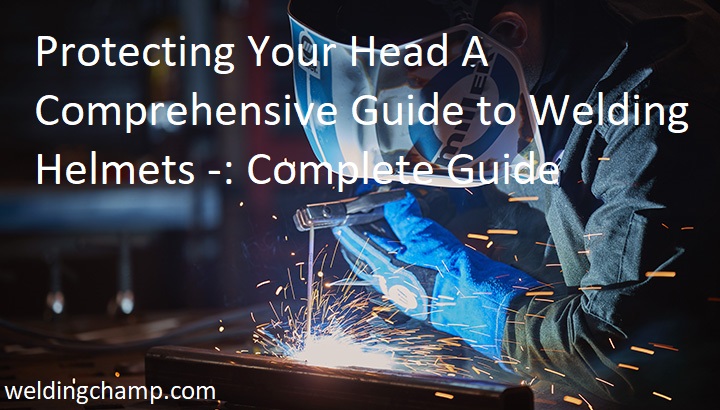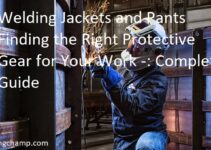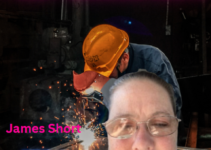Are you a welder looking for the safest way to protect your head? You’re in the right place. This comprehensive guide discusses what to look for in a high-quality welding helmet and provides helpful suggestions to find the one that fits you best.
Put your safety first, and take care of your head–it’s your most valuable asset!
The purpose of this guide is to provide an in-depth overview of the different types of welding helmets and their potential uses. While many consumers may think of welding helmets as a standard piece of safety equipment, in actuality, there is a variety of specialized welding helmets available today. Each helmet offers its own unique set of features and benefits that you should consider when shopping for a helmet.
This guide will cover topics such as the importance of using a welding helmet, types of lenses used for protection, and features to look for in various types of helmet models. It will also discuss necessary maintenance procedures and offer advice on selecting the right size and shape for optimal performance. By utilizing this comprehensive guide, you will have all the necessary information to ensure your safety when handling any type or size application that requires the use of a welding helmet.
Helmet selection factors
Choosing the right welding helmet often requires answers to a variety of important questions that include parts, comfort, technology and price. Read on for an overview of the factors you need to consider.
Parts: A quality welding helmet is made up of several parts which come together to provide protection and enhanced vision while welding. Your choice should include an outer shell, a filter plate lens assembly and one or more protective lenses/filters. Additionally, you may want to look at shields that fit over the top of your helmet for extra protection against sparks and fumes.
Comfort: A good fit is crucial when it comes to welding helmets, because uncomfortable gear can lead to fatigue and sloppy welds. Look for features like adjustable headbands for personalized comfort as well as sweat-absorbing fabric liners that allow more air circulation and greater comfort during long stints in the shop. It’s also important to make sure the helmet shell has adequate ventilation since hot heads can result in distraction from your work.
Technology: State-of-the-art technology is likely most important when deciding on a welding helmet because it relates directly to safety, performance and convenience on the job site. Automated features such as “self darkening” lenses offer instant shade at the flip of a switch while blocking dangerous UV radiation in the process—and save time by eliminating frequent stops mid-project while readjusting shade levels manually. Other advanced options like built-in grind modes with generous viewing areas are just some of what modern helmets have to offer today’s workers and hobbyists alike—allowing them unprecedented versatility with each project they take on around the shop or garage.
Price: Welding helmets aren’t too expensive compared to many other tools & equipment pieces found around a typical shop space, but they aren’t free either! Prices vary mostly based upon features offered (or excluded) from various models – though luckily there are usually plenty of budget friendly options available from most brands nowadays too.
Lens shade
A proper welding helmet has a lens shade which is essential for safety and visibility. The shade usually runs from #8 to #14, with #8 being the lightest and offering the least amount of protection from Ultraviolet (UV) and Infrared (IR) radiation and #14 being the darkest, offering maximum protection. Different types of welding require different lens shades.
For instance:
- #8 is suitable only for flame cutting or light- or low-amperage arc welding, like sheet metal or jewelry.
- #10 is the most comfortable shade for electric arc welding since it allows good visibility while also providing adequate protection from UV and IR radiation.
- #11 to #13 are often used with low amperage TIG or MMA (Stick) welding where there is limited penetration depth.
- #14 is used if you are doing any kind of high amperage TIG or MMA welding as well as gas metal arc welding (GMAW), flux cored arc welding (FCAW) and where there is greater risk of spatter build up on the lens.
Viewing area
The size of the viewing area for a welding helmet is an important consideration for welders when it comes to selecting the right helmet. The viewport is the part of the helmet that allows you to see what you are working on, and it should be large enough to provide sufficient vision while also offering adequate protection from arc radiation.
Most welding helmets now have a number of fixed viewing sizes, ranging from 2 square inches to 12 square inches. While larger viewports are generally more comfortable and give welders better visibility, they may not offer enough arc protection in certain instances where concentrated UV or IR radiation is present.
Be sure to check with your employer or safety department before making your purchase if you are unsure about what size works best for your specific needs.
Helmet maintenance and care
Helmet maintenance is an important part of safety. Since your helmet is such an essential part of your protective gear, it’s important to take steps to ensure it remains in good condition. Knowing how to properly clean and store the helmet can significantly extend its lifespan, allowing you to use it for longer without having to purchase a new one.
Like any other protective gear, welding helmets require regular maintenance and inspection. If anything looks off or feels out of the ordinary, it’s highly recommended that you seek professional assistance from a certified inspector as soon as possible. Here are some tips for taking care of your helmet:
- Read and understand the manufacturer’s instructions about proper use and care
- Clean the lenses before use with lens cleaner or lint free wipes
- Clean sweatband frequently with mild soap and water
- Check all seals, straps, and components periodically for any damage or signs of wear
- Store the helmet in a cool dry place when not in use

Cleaning the helmet
A welders helmet is a vital piece of equipment to protect your eyes and face from the bright flashes and sparks created by welding. Like any other equipment, it needs to be properly cleaned and maintained in order to function correctly. In this section, we will look at the different steps involved in cleaning a welding helmet, so that it can continue to offer you optimal protection.
First, begin by disconnecting the power supply from the helmet. This should be done carefully. After doing so, you will need to clean your helmet with a mild soap or detergent and some warm water. You should use a soft cloth for best results; avoid using abrasive materials such as steel wool, as these can scratch and damage your helmet’s surface. Carefully wipe down all areas of the exterior of your helmet with the soapy cloth until it is clean.
Once that is done, rinse off the residue with clean water and dry using another soft cloth or paper towel. Be sure not to leave any moisture on your helmet as this can lead to rusting over time. It is also important that all parts of the helmet remain unsoaked while being rinsed off; do not let water seep into any of its components or try to submerge it in water!
Finally, apply a coat of specialized vinyl protectant with a lint-free cloth (not included) following manufacturer instructions given on product label – this helps maintain luster on plastic surfaces exposed to UV rays over time!
Replacing parts
Replacing the parts of your welding helmet is an important way to protect yourself from welding hazards. The exterior shell, lenses, and other protective components may need to be replaced if they become corroded or worn over time. Additionally, any improperly fitting or missing parts could reduce the safety provided by your helmet.
It’s best to replace pieces as needed instead of attempting repairs that might not be successful in protecting you adequately. It’s recommended that you periodically inspect all components of your welding helmet and replace them proactively instead of waiting until they fail altogether. Check the fit of the hard hat and make sure it fits securely without compromising its effectiveness. Check the speed at which the lenses open and close as well as their clarity; if they are slow or less than perfect, replace them immediately. Additionally, inspect all shrouds, gauges, seals and lenses for signs of wear or damage; these components should all be replaced if there is any damage at all.
Welding helmets protect workers from arc ray burn injuries caused by solar radiation exposure during welding activities; at a minimum for safety it is critical that each component tightens properly and performs flawlessly when tested in use conditions each time it is worn on a job-site. In addition to replacing parts proactively, regularly clean the shell with mild detergents while avoiding abrasive products that could degrade protective layers on the lens surface.
Helmet accessories
To give you the protection and comfort you need while welding, there are a variety of helmet accessories that you may find useful. Knowing what’s available and how to choose the right accessory can make your welding safer and more comfortable. Here’s a list of helmet accessories to consider.
Replacement Sensors: As mentioned earlier, the sensors in auto darkening helmets must be replaced periodically in order to maintain the eye protection they provide. Make sure you use manufacturer approved helmets when replacing sensors in your welding helmet as well as follow manufacturer instructions for installation and maintenance of your replacement parts.
Lenses: Replacing lenses is another way to ensure that you have sufficient eye protection from hazards during welding. It’s important to purchase the correct lenses for your helmet type that provide for adequate shade when necessary without causing glare or obstructing vision. Likewise, it’s important to use only reliable components that meet ASTM 2015 Std. or higher standards when replacing lenses in any brand of helmet (including Miller Electric).
Filter Plates: All professional-grade welding helmets must include filter plates with each new product purchase since they are essential components required for shielding light from reaching your eyes during certain types of welding processes such as TIG (Gas Tungsten Arc Welding). Unless specified by the manufacturer, these filter plates should always be made out of durable materials like stainless steel or aluminum alloy in order to effectively protect against radiation emitted during certain weld processes without causing UV damage over time which could potentially impair vision permanently. Check what type of material is specified for any given product before purchasing replacement filter plates – ones not recommended by their manufacturers should never be used!
Respirators
When Welding, it is important to take proper safety precautions such as wearing a welding helmet and respirator. Respirators are an integral part of any welding safety program as they provide protection against airborne contaminants. Welders must always wear a respirator when welding, grinding, cutting or other activities that may expose them to harmful fumes and particles from the process.
Respirators are designed to filter out dust, smoke, fumes and other airborne contaminants while providing the welder with a breathable environment that won’t obstruct their work. Respirators come in various forms including cartridge-type dust masks and air-purifying respirators; be sure to choose one that is right for the job being done. The U.S. Department of Labor recommends filtering facepiece respirators for most welding applications, as these provide the best combination of comfort and protection available today.
Welders should be fitted for a good respirator; choosing one too small or large will not Fitting your respiratory system properly will ensure adequate protection from any hazardous particles in the air during operation time. It is also important to regularly check your respirator for damage or deterioration and replace when necessary, as it can no longer protect you effectively when this happens. Additionally all other components should be inspected prior to each use to ensure all straps are tight enough around your face without being too tight, filters (or cartridges) are in place, etc., so that all safety requirements are met before working begins.
Hard hat adapters
Hard hat adapters enable the welding helmet to be securely mounted to a hard hat. This is perfect for welders who need extra protection from falling debris or must work in close quarters or cramped areas for long periods of time.
The adapter should fit snugly over the hard hat, with clips that are fitted onto the sides or rear of the helmet. Most adapters will also include a chin strap, which can help secure the helmet while welding and provide greater freedom of motion than other adjusting systems.
Depending on the individual design, flush mounting adapters are available which minimise obstruction and do not interfere with the welder’s vision when looking through their lens.
To ensure maximum safety, check with your employer to ensure that you’re using the right kind of hardhat adapter for your particular hard hat system before starting welding operations.
Conclusion
Welding helmets are essential for protecting your head, face, and eyes from welding sparks and spatter. When choosing a helmet, be sure to pick one that fits you comfortably, has the appropriate optical rating for your welding application, comes with the necessary safety certifications, and offers sensor technology that is compatible with the type of welding you will be doing. You should also consider convenience features such as auto-darkening lens control and adjustability settings that can help you stay comfortable while welding.
With the right helmet in hand, you are now fully prepared to tackle any welding job safely and without fear of being injured by flying sparks or miscalculated welds!
FAQ’S
What head protection do welders use?
Welders typically use a welding helmet or a welding hood as their head protection.
How do I protect my welding helmet?
To protect your welding helmet, store it in a cool and dry place, avoid dropping or hitting it, and clean it regularly with a soft cloth and mild soap.
What are the safety standards for welding helmets?
Welding helmets must meet safety standards such as ANSI Z87.1 and EN175 to ensure they provide adequate protection against radiation and impact.
How should a welding helmet sit on your head?
A welding helmet should fit snugly on your head, with the lens positioned correctly in front of your eyes, and the chin strap securely fastened.
What is the best type of welding helmet?
The best type of welding helmet depends on personal preferences and needs. Some popular types include auto-darkening helmets, passive helmets, and flip-front helmets.
What are the two types of welding helmet?
The two main types of welding helmets are passive helmets and auto-darkening helmets.
What is the welding helmet called?
A welding helmet is also referred to as a welding hood, welding mask, or welding goggles.
What are the 2 types of radiation that your welding helmet will protect you from?
Welding helmets protect against two types of radiation: ultraviolet (UV) radiation and infrared (IR) radiation.
What is used for head protection?
Head protection for welding can include welding helmets, welding hoods, or welding caps.
What are the different types of welding head?
Different types of welding head protection include welding helmets, welding hoods, welding caps, welding beanies, and welding bandanas.
See more-
- Best pants for welding 2023
- Best tig welding gloves 2023
- Best welding boots 2023
- Best welding caps 2023
- Best welding cart 2023


